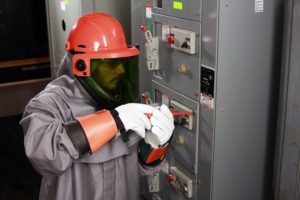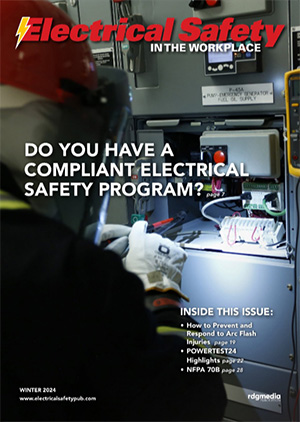Six “Musts” For Working on Or Near Energized Equipment
By:David Weszley, Contributor
Electricity is present in every workplace. When it is necessary to service, maintain, or modify an electrical system that is “live,” here are six action items that must be addressed:
- NFPA 70E electrical safe work practices 2021 edition must be used when working on or near energized equipment.
 NFPA 70E 2021 requirements must be followed, starting with electrical safety work practices involving 50V or more. The first priority for any company is to de-energize any electrical equipment. Make sure it is in electrically safe condition before working on the equipment. There are steps when replacing a component, such as a circuit breaker or fuse. First, de-energize the equipment. The second important step is to de-energize upstream, where the energy is fed from. Turn off the power and perform lockout tagout (LOTO).
NFPA 70E 2021 requirements must be followed, starting with electrical safety work practices involving 50V or more. The first priority for any company is to de-energize any electrical equipment. Make sure it is in electrically safe condition before working on the equipment. There are steps when replacing a component, such as a circuit breaker or fuse. First, de-energize the equipment. The second important step is to de-energize upstream, where the energy is fed from. Turn off the power and perform lockout tagout (LOTO).
You may think you have de-energized the equipment, but importantly, you need to verify. This is huge. Check with a voltage meter if any energy is still live. This is the only official way to determine a zero-energy state. Try to turn the motor on, if it doesn’t turn on, you assume it is off. But energy can be fed from multiple sources or there can be a delayed stoppage. Confirm your assumptions.
What can be done while equipment is energized, such as when troubleshooting, voltage testing, visual inspection? One, wear personal protective equipment (PPE) while doing this work, per 70E requirements. Two, set up an approach boundary surrounding the equipment that is exposed, such as when the cover is off a panel.
There are specifically designated types of boundaries, per 70E — the limited approach boundary, the restricted boundary, the arc flash boundary. To give a visual warning of the boundary’s parameters, put cones, tapes, etc. around whichever boundary is furthest from the equipment.
The restricted boundary is for shock protection, where you can contact the equipment. Within the restricted boundary you need to use insulated tools.
With the limited approach boundary, you’re a couple steps back from the equipment, approximately 36 to 42 inches. Bear in mind, you must wear PPE.
The arc flash boundary is decided by NFPA 70E calculation, or a qualified person comes out and does the calculation. An arc flash boundary can range from six, ten, twenty feet, or more. Completing an incident energy analysis is “boots on the ground” territory. Qualified workers are physically removing covers, looking inside, conducting visual inspection, looking at types of breakers, wire size, and logging that information. That information is compiled and sent to an electrical engineer. He/she then calculates the incident energy number. This is an extremely important assessment, telling you how dangerous the hazard is.
Does every piece of electrical equipment have arc flash potential? No. That is why you get an incident energy analysis completed. The equipment label will tell you the voltage, the arc flash boundary and necessary level of PPE.
- An Energized Electrical Work Permit (EEWP) is required by every company when work on or near energized equipment is deemed necessary by the company because power cannot be turned off.
An example is not being able to turn off a ventilation system in a hospital critical care unit, or perhaps an alarm system. In cases such as this you must fill out the permit. One section of the permit is called “justification.” Here you explain why you are doing work on energized equipment and why it cannot be de-energized. Several signatures (by a qualified person and managers) are required on the form. You need this documentation if someone is injured while working on energized equipment and OSHA, for example, is contacted.
- To determine if electrical equipment is energized after lockout tagout, you need to use a voltage meter to test it.
You can’t rely on a visual inspection. For example, someone working on equipment may ask a co-worker to flip breaker 20 to de-energize it, but the co-worker flips breaker 21. The person working on the equipment cannot distinguish breakers 20 from 21: this is why you verify that there is no voltage on the right breaker or switch.
- You must use insulated tools in the restricted approach boundary if you are working on energized equipment.
When you are really close to energized equipment while working, say within six inches, anything in your hands within this restricted boundary, a tool in your hand, may come in contact with the equipment. Or you might accidentally drop the tool. If it is not insulated, it will cause an arc flash, blowing up the equipment and yourself.
Here is another example of what can happen: You’re tightening a component with an adjustable wrench. The equipment gets loose due to vibration, and the tool handle accidently touches the energized equipment. You get a cross connection causing an arc flash.
- It is important to understand the types of PPE you need to wear when working on or near energized equipment.
There are two methods to determine required PPE. One, labels on equipment can tell you the results of an incident energy analysis and the distance you must maintain from the equipment. Two, if the equipment does not have a label, you need to use arc flash PPE category NFPA 70E tables (130.7c15a).
An incident energy study is conducted to determine the level of incident energy a piece of equipment has. Not everyone does an incident energy study. If you get a new piece of equipment, you need to do an incident energy analysis. It can be done in-house if you have a qualified engineer, or you can use the services of a third party.
You need to know important electrical numbers. The average person probably will not know these figures, such as available fault current and fault clearing times for breakers. Equipment labeling is extremely helpful. An equipment arc flash label is also extremely useful. Training helps you understand these numbers. If you do not understand, you’re going in rather blind to work on or near energized equipment.
Sometimes your task changes while working on electrical equipment. NFPA 70E 2021 edition has been revised to state that when you turn equipment back on; when a circuit breaker has been replaced or maintenance performed, there is a chance an arc flash could occur when re-energizing equipment. The 70E 2021 edition states you should wear PPE the first time you turn equipment back on.
- Only a qualified person can enter the restricted approach boundary.
The limited approach boundary can be entered by an unqualified person for training purposes only. The unqualified person cannot touch or feel the equipment. He or she must wear PPE and have their hands to their sides, strictly visually learning.
To obtain the status of a qualified person, workers 1) need to know how to protect himself or others around them from electrical hazards and arc flash; this is a must; 2) they must have electrical safety training every three years, as NFPA 70E is revised every three years; 3) they must have knowledge of the equipment he or she is working on; and 4) they must demonstrate their skills to a designated person from the company; probably the most knowledgeable person, another qualified person. (Who the company designates to be designated person is at the discretion of the company.)
One more point to consider: OSHA inspectors use NFPA standard 70E to educate them on what to look for and to understand when conducting electrical safety enforcement inspections. Compliance officers can and do use the OSHA General Duty Cause to enforce electrical safety in the workplace — “Each employer shall furnish to each of his employees employment and a place of employment which are free from recognized hazards that are causing or are likely to cause death or serious physical harm to his employees.” Arc flash or shock are recognized hazards. ESW
Share on Socials!
Electrical Arc Injuries: A Complex Multi-Physical Injury Dynamic
What Are Absence of Voltage Testers and How Are They Used?
The Ins and Outs of an Infrared Inspection Service
Leaders in Electrical Safety
• Aramark
• Bowtie Engineering
• Enespro
• Ericson
• I-Gard Corporation
• IRISS
• KERMEL, INC.
• Lakeland Industries
• MELTRIC Corporation
• National Safety Apparel
• National Technology Transfer
• Oberon
• Saf-T-Gard
• SEAM Group
Subscribe!
Sign up to receive our industry publications for FREE!







